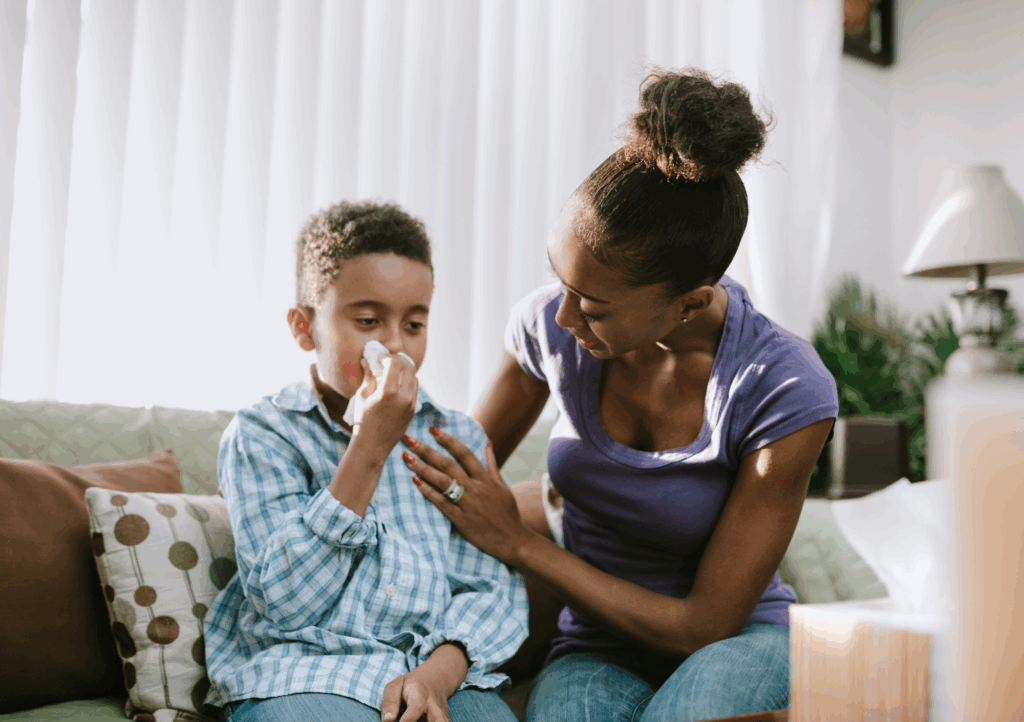Sunshine, Wildflowers… and Allergy Season
For many Texans, spring means longer days, blooming flowers, and outdoor fun—but it also brings a wave of Texas spring breathing issues like sneezing, coughing, and shortness of breath. If you or your child has been struggling to breathe clearly this season, you’re not alone.
Across Texas, especially in communities like Baytown, Atascocita, and Houston, springtime allergens are in full swing. What starts as a mild allergy flare-up can sometimes feel much more serious. So how do you know whether you’re dealing with allergies, asthma, or a more concerning issue?
This guide will help Texas families spot the difference, understand when home care is enough, and know when it’s time to seek emergency help, especially for children, older adults, and anyone with chronic health conditions.

What’s Behind Texas Spring Breathing Issues In Spring (and Early Summer)?
In Texas, allergy season doesn’t end with spring break. By the time we reach May, many are still struggling with tree pollen, grasses, and rising mold levels. Early summer introduces a fresh wave of airborne irritants.
In areas like Atascocita and Baytown, the air stays thick with oak, ash, and elm pollen well into May. As temperatures rise, grasses like Bermuda and Timothy trigger sneezing fits and asthma flare-ups. Mold spores also thrive after spring rains, especially with increasing humidity.
But it’s not just pollen and mold, ozone levels tend to rise in early summer across southeast Texas. On hot, sunny days with little wind, ozone pollution builds up, aggravating respiratory conditions even in those without asthma.
If you or your child is experiencing coughing, wheezing, shortness of breath, or persistent sinus pressure, it might be more than just allergies.

Allergies, Asthma, or Something More Serious?
When your child wakes up coughing or you’re short of breath after a walk, it’s easy to assume it’s just allergies. But in Texas, spring and early summer can blur the lines between mild symptoms and more serious issues.
Allergies
Typical symptoms:
- Sneezing
- Runny or stuffy nose
- Itchy, watery eyes
- Mild coughing or throat irritation
These usually come and go with pollen levels or outdoor exposure and often improve with over-the-counter treatments.
Asthma
Often triggered by allergens, asthma symptoms include:
- Wheezing (a whistling sound when breathing)
- Chest tightness
- Persistent coughing, especially at night or with activity
- Shortness of breath
Kids may not say “I can’t breathe,” but they might slow down or avoid activity. Adults may confuse tightness with anxiety or overexertion.
Something More Serious
Not all breathing problems are allergy-related. Warning signs of something more serious include:
- A fever (which doesn’t happen with allergies or asthma)
- Labored breathing or gasping for air
- Chest pain
- Confusion or extreme fatigue
- No relief after using prescribed inhalers or medication
These symptoms could point to bronchitis, pneumonia, RSV, or other infections, and they need urgent medical attention.
If you’re unsure, err on the side of caution. Breathing trouble can escalate quickly, especially in young children, older adults, or anyone with chronic conditions.

When to Head to the ER (and Why It Matters)
Most allergy and asthma symptoms can be handled at home. But when breathing becomes difficult or symptoms don’t improve, acting quickly matters.
Go to the ER immediately if:
- Breathing becomes severely difficult or worsens fast
- Lips, face, or fingernails turn bluish
- Chest pain doesn’t improve
- Wheezing continues despite using an inhaler
- A child is lethargic, gasping, or unresponsive
- High fever is paired with coughing or difficulty breathing
- Symptoms appear suddenly or don’t respond to usual meds
In children, look for signs like flaring nostrils, sucking in at the ribs, or simply refusing to eat or talk. These subtle signs matter.
Delaying care can lead to complications, timing makes a difference.

Managing Texas Spring Breathing Issues at Home
Not every sneeze or wheeze requires a hospital visit. With a few smart strategies, many symptoms can be handled safely at home.
At-Home Relief Tips:
- Check the pollen count
- Shower and change clothes after being outdoors
- Keep windows closed during peak pollen hours
- Use HEPA air filters indoors
- Take medications as prescribed, and always keep rescue inhalers nearby
- Stay hydrated and well rested
Extra Tips for Kids
Younger children may not be able to describe what they’re feeling. Watch for:
- Extra clinginess or irritability
- Faster breathing than normal
- Trouble feeding (in infants) or avoiding playtime (in toddlers and older kids)
If symptoms are manageable, great. But if you’re unsure, or you’re seeing anything that feels “off”, trust your gut. When breathing becomes difficult or symptoms aren’t getting better, don’t wait it out.

When Home Care Isn’t Enough: Knowing Where to Turn
Even with great at-home care, some breathing symptoms go beyond what’s manageable. That’s especially true during Texas allergy season, when flare-ups can come on fast.
If symptoms worsen despite treatment, or you’re unsure what’s causing shortness of breath, having access to emergency care nearby can make all the difference.
Whether it’s evaluating a child’s wheezing or managing sudden coughing spells, local emergency teams trained in pediatric and adult care can offer fast answers and support when you need it most.
Breathe easier knowing there’s help close to home.
Helpful Resources
Breathing trouble is never something to ignore. Whether it’s persistent sneezing or something more serious, knowing the signs and where to go can keep your family safe.
Most seasonal symptoms improve with air filters, allergy meds, and close monitoring. But if they don’t, or you’re unsure, it’s okay to ask for help.
For the latest updates on respiratory trends in Texas, check these trusted resources:
And when breathing concerns can’t wait, Family First ER is open 24/7, offering compassionate care for both children and adults.


